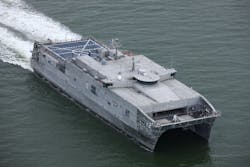Navy may consider Expeditionary Fast Transport (EPF) surface vessel as an autonomous missile and UAV carrier
WASHINGTON – The U.S. Navy Expeditionary Fast Transport (EPF) surface vessel is a catamaran-like transport ship formerly dubbed the Joint High Speed Vessel. Now the Navy is exploring machine autonomy for this ship. The Motley Fool reports. Continue reading original article
The Military & Aerospace Electronics take:
25 June 2021 -- Ordinarily, in addition to its passengers, an EPF carries a crew of 26 -- but the USNS Apalachicola (EPF 13) will be designed to operate in autonomous mode either with a crew or without.
The ship will include a perception and autonomy control suite, as well as several automation enhancements to reduce the number of personnel necessary for operations and maintenance at sea, say officials of the vessel's manufacturer, Austal USA in Mobile, Ala. The ship even could be operated entirely remotely as an unmanned surface vessel.
Navy leaders may consider using the EPF for the Large Unmanned Surface Vessel (LUSV) by adding vertical missile launch cells to convert the ship to a robotic guided-missile cruiser. The flat-topped EPF also is designed to support helicopter operations, so it has potential to support unmanned helicopters for autonomous flight operations.
John Keller, chief editor
Military & Aerospace Electronics
